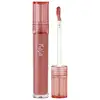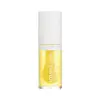What's inside
What's inside
 Key Ingredients
Key Ingredients

 Benefits
Benefits

 Concerns
Concerns

 Ingredients Side-by-side
Ingredients Side-by-side

Polybutene
Hydrogenated Polyisobutene
EmollientHydrogenated Polydecene
EmollientDiisostearyl Malate
EmollientOctyldodecanol
EmollientEthylene/Propylene Copolymer
AbrasiveSilica Dimethyl Silylate
EmollientEthylene/Propylene/Styrene Copolymer
Rosa Canina Fruit Oil
EmollientSimmondsia Chinensis Seed Oil
EmollientSqualane
EmollientVanilla Tahitensis Fruit Extract
Skin ConditioningSorbitan Isostearate
EmulsifyingVp/Hexadecene Copolymer
CI 77891
Cosmetic ColorantSynthetic Fluorphlogopite
Polyglyceryl-2 Triisostearate
EmulsifyingIron Oxides
CI 15985
Cosmetic ColorantButylene/Ethylene/Styrene Copolymer
Dehydroacetic Acid
PreservativeMica
Cosmetic ColorantCI 15850
Cosmetic ColorantPolyglyceryl-2 Diisostearate
EmulsifyingCI 42090
Cosmetic ColorantPentaerythrityl Tetra-Di-T-Butyl Hydroxyhydrocinnamate
AntioxidantTin Oxide
AbrasiveTriethoxycaprylylsilane
Butylene Glycol
HumectantWater
Skin ConditioningParfum
MaskingPolybutene, Hydrogenated Polyisobutene, Hydrogenated Polydecene, Diisostearyl Malate, Octyldodecanol, Ethylene/Propylene Copolymer, Silica Dimethyl Silylate, Ethylene/Propylene/Styrene Copolymer, Rosa Canina Fruit Oil, Simmondsia Chinensis Seed Oil, Squalane, Vanilla Tahitensis Fruit Extract, Sorbitan Isostearate, Vp/Hexadecene Copolymer, CI 77891, Synthetic Fluorphlogopite, Polyglyceryl-2 Triisostearate, Iron Oxides, CI 15985, Butylene/Ethylene/Styrene Copolymer, Dehydroacetic Acid, Mica, CI 15850, Polyglyceryl-2 Diisostearate, CI 42090, Pentaerythrityl Tetra-Di-T-Butyl Hydroxyhydrocinnamate, Tin Oxide, Triethoxycaprylylsilane, Butylene Glycol, Water, Parfum
Polyglyceryl-2 Isostearate/Dimer Dilinoleate Copolymer
EmollientHelianthus Annuus Seed Oil
EmollientSimmondsia Chinensis Seed Oil
EmollientTocopheryl Acetate
AntioxidantOlea Europaea Fruit Oil
MaskingSilica Dimethyl Silylate
EmollientCamellia Japonica Seed Oil
EmollientCamellia Sinensis Seed Oil
HumectantArgania Spinosa Kernel Oil
EmollientMacadamia Ternifolia Seed Oil
EmollientRosa Damascena Flower Water
MaskingMonascus Extract
Skin ConditioningMentha Viridis Leaf Oil
AstringentEclipta Prostrata Extract
Skin ConditioningRubus Idaeus Fruit Extract
AstringentVaccinium Angustifolium Fruit Extract
Skin ProtectingMorus Alba Root Extract
BleachingFragaria Vesca Fruit Extract
AstringentOriganum Vulgare Leaf Extract
Skin ConditioningChamaecyparis Obtusa Leaf Extract
Skin ConditioningSalix Alba Bark Extract
AstringentMelia Azadirachta Leaf Extract
Skin ConditioningLactobacillus/Soybean Ferment Extract
Skin ConditioningPortulaca Oleracea Extract
Skin ConditioningCinnamomum Cassia Bark
Skin ConditioningScutellaria Baicalensis Root Extract
AstringentMoringa Oleifera Seed Oil
EmollientPolyhydroxystearic Acid
EmulsifyingCeramide NP
Skin ConditioningLecithin
EmollientIsostearic Acid
CleansingIsopropyl Myristate
EmollientEthylhexyl Palmitate
EmollientDiisostearyl Malate
EmollientDehydroacetic Acid
PreservativePolyglyceryl-3 Polyricinoleate
EmulsifyingTocopherol
AntioxidantParfum
MaskingCI 15850
Cosmetic ColorantCI 15985
Cosmetic ColorantBenzyl Benzoate
AntimicrobialPolyglyceryl-2 Isostearate/Dimer Dilinoleate Copolymer, Helianthus Annuus Seed Oil, Simmondsia Chinensis Seed Oil, Tocopheryl Acetate, Olea Europaea Fruit Oil, Silica Dimethyl Silylate, Camellia Japonica Seed Oil, Camellia Sinensis Seed Oil, Argania Spinosa Kernel Oil, Macadamia Ternifolia Seed Oil, Rosa Damascena Flower Water, Monascus Extract, Mentha Viridis Leaf Oil, Eclipta Prostrata Extract, Rubus Idaeus Fruit Extract, Vaccinium Angustifolium Fruit Extract, Morus Alba Root Extract, Fragaria Vesca Fruit Extract, Origanum Vulgare Leaf Extract, Chamaecyparis Obtusa Leaf Extract, Salix Alba Bark Extract, Melia Azadirachta Leaf Extract, Lactobacillus/Soybean Ferment Extract, Portulaca Oleracea Extract, Cinnamomum Cassia Bark, Scutellaria Baicalensis Root Extract, Moringa Oleifera Seed Oil, Polyhydroxystearic Acid, Ceramide NP, Lecithin, Isostearic Acid, Isopropyl Myristate, Ethylhexyl Palmitate, Diisostearyl Malate, Dehydroacetic Acid, Polyglyceryl-3 Polyricinoleate, Tocopherol, Parfum, CI 15850, CI 15985, Benzyl Benzoate
Ingredients Explained
These ingredients are found in both products.
Ingredients higher up in an ingredient list are typically present in a larger amount.
Ci 15850 is the pigment color red. It is an azo dye and created synthetically.
Azo dyes need to be thoroughly purified before use. This allows them to be more stable and longer-lasting.
This ingredient is common in foundations, lipsticks, and blushes. This color is described as brown/orangey red.
It has many secondary names such as Red 6 and Red 7. According to a manufacturer, Red 6 usually contains aluminum.
Learn more about CI 15850Ci 15985 is a dye made from petroleum. It is synthetically created and approved by the FDA for use in foods and cosmetics.
The color of this dye is orange/yellow.
This ingredient can be found in makeup, sun care, and skincare.
Learn more about CI 15985Dehydroacetic Acid is fungicide and bactericide. It is used as a preservative in cosmetics. Preservatives help elongate the shelf life of a product.
Dehydroacetic Acid is not soluble in water.
Diisostearyl Malate is an emollient and most often used in lip products. It comes from isostearyl alcohol, a fatty acid, and malic acid, an AHA.
As an emollient, Diisostearyl Malate helps create a thin film on your skin to trap moisture in. This helps keep your skin soft and smooth.
Parfum is a catch-all term for an ingredient or more that is used to give a scent to products.
Also called "fragrance", this ingredient can be a blend of hundreds of chemicals or plant oils. This means every product with "fragrance" or "parfum" in the ingredients list is a different mixture.
For instance, Habanolide is a proprietary trade name for a specific aroma chemical. When used as a fragrance ingredient in cosmetics, most aroma chemicals fall under the broad labeling category of “FRAGRANCE” or “PARFUM” according to EU and US regulations.
The term 'parfum' or 'fragrance' is not regulated in many countries. In many cases, it is up to the brand to define this term.
For instance, many brands choose to label themselves as "fragrance-free" because they are not using synthetic fragrances. However, their products may still contain ingredients such as essential oils that are considered a fragrance by INCI standards.
One example is Calendula flower extract. Calendula is an essential oil that still imparts a scent or 'fragrance'.
Depending on the blend, the ingredients in the mixture can cause allergies and sensitivities on the skin. Some ingredients that are known EU allergens include linalool and citronellol.
Parfum can also be used to mask or cover an unpleasant scent.
The bottom line is: not all fragrances/parfum/ingredients are created equally. If you are worried about fragrances, we recommend taking a closer look at an ingredient. And of course, we always recommend speaking with a professional.
Learn more about ParfumThis silica is mainly used to thicken oils and suspend particles in oils. It is not water soluble.
According to the manufacturer, it:
The manufacturer also claims this ingredient to be useful in makeup.
In lipstick formulations, this ingredient improves color payoff, reduces pigment settling, and reduces oil bleeding. This ingredient also improves the grip of powder products such as dry shampoos.
Learn more about Silica Dimethyl SilylateThis oil comes from the seeds of the desert shrub called Jojoba. It is more commonly known as jojoba oil, a non-comedogenic oil.
Jojoba oil does not contain fragrance and has many fatty-acids, making it a great soothing ingredient.
It also contains Vitamin E, a great moisturizing ingredient. Vitamin E is also an antioxidant and protects your skin against oxidative damage.
This ingredient humectant properties, meaning it helps draw moisture from the air. This helps keep your skin hydrated.
While jojoba has antibacterial properties, it is only able to kill some strains of bacteria.
Studies also show it helps in wound healing. In fact, Indigenous cultures have used jojoba as a moisturizer and to help treat burns for centuries.
Fun fact: Jojoba oil similar to natural human skin sebum, so it has a great effect on dry skin. It is also promising with helping to regulate sebum production.
Due to its fatty acid content, Jojoba oil may not be fungal acne safe. We recommend speaking with a professional if you have any concerns.
Learn more about Simmondsia Chinensis Seed Oil